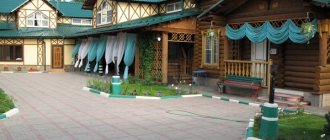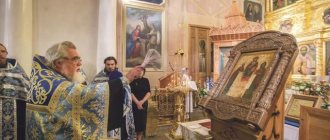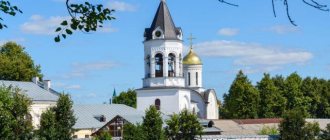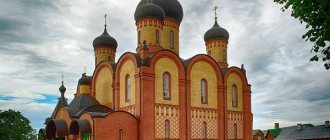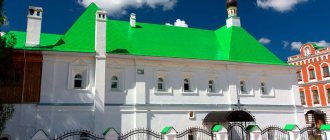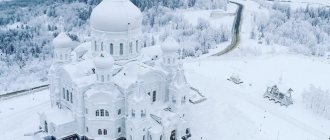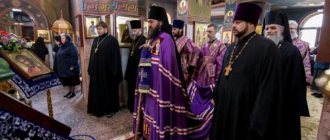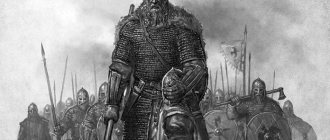Mir
Russia Ivanovo region village of Vvedenye Nikolo-Shartomsky monastery in Vvedenye Map is loading…
{"format":"leaflet","minzoom":false,"maxzoom":false,"limit":50,"offset":0,"link":"all","sort":[""], "order":[],"headers":"show","mainlabel":"","intro":"","outro":"","searchlabel":"\u2026 \u0441\u043b\u0435\ u0434\u0443\u044e\u0449\u0438\u0435 \u0440\u0435\u0437\u0443\u043b\u044c\u0442\u0430\u0442\u044b","default":"","import-annotation":false,"width ":"auto","height":"350px","centre":{"text":"","title":"""link":"""lat":56.96597700000000230602381634525954723358154296875,"lon": 41.3407389999999992369339452125132083892822265625,"icon":""},"title":"","label":"","icon":"","lines":[],"polygons":[],"circles":[ ],"rectangles":[],"copycoords":false,"static":false,"zoom":8,"defzoom":14,"layers":["OpenStreetMap"],"image layers":[] ,"overlays":[],"resizable":false,"fullscreen":true,"scrollwheelzoom":true,"cluster":false,"clustermaxzoom":9,"clusterzoomonclick":true,"clustermaxradius":80, "clusterspiderfy":true,"geojson":"","clicktarget":"","showtitle":true,"hidenamespace":false,"template":"","userparam":"","activeicon": "","pagelabel":false,"ajaxcoordproperty":"","ajaxquery":"","locations":[{"text":"\u003Cb\u003E\u003Ca href=\"/palomnik/%D0% 9D%D0%B8%D0%BA%D0%BE%D0%BB%D0%BE-%D0%A8%D0%B0%D1%80%D1%82%D0%BE%D0%BC%D1%81 %D0%BA%D0%B8%D0%B9_%D0%BC%D1%83%D0%B6%D1%81%D0%BA%D0%BE%D0%B9_%D0%BC%D0%BE%D0 %BD%D0%B0%D1%81%D1%82%D1%8B%D1%80%D1%8C_%D0%B2%D0%BE_%D0%92%D0%B2%D0%B5%D0%B4 %D0%B5%D0%BD%D1%8C%D0%B5\" title=\"\u041d\u0438\u043a\u043e\u043b\u043e-\u0428\u0430\u0440\u0442\u043e\u043c\u0441\ u043a\u0438\u0439 \u043c\u0443\u0436\u0441\u043a\u043e\u0439 \u043c\u043e\u043d\u0430\u0441\u0442\u044b\u0440\u044c \u0432\u 043e\u0412\u0432\u0435\u0434\ u0435\u043d\u044c\u0435\»\u003E\u041d\u0438\u043a\u043e\u043b\u043e-\u0428\u0430\u0440\u0442\u043e\u043c\u0441\u043a\u0438\u 0439\u043c\u0443\u0436 \u0441\u043a\u043e\u0439 \u043c\u043e\u043d\u0430\u0441\u0442\u044b\u0440\u044c \u0432\u043e \u0412\u0432\u0435\u0434\u0435 \u043d\u044c\u0435\u003C/a \u003E\u003C/b\u003E\u003Chr /\u003E\u003Ca href=\»/palomnik/%D0%A1%D0%B2%D0%BE%D0%B9%D1%81%D1%82%D0%B2 %D0%BE:%D0%90%D0%BD%D0%BD%D0%BE%D1%82%D0%B0%D1%86%D0%B8%D1%8F\" title=\"\u0421\ u0432\u043e\u0439\u0441\u0442\u0432\u043e:\u0410\u043d\u043d\u043e\u0442\u0430\u0446\u0438\u044f\u003E\u0410\u043d\u043d\u 043e\u0442\u0430\u0446 \u0438\u044f\u003C/a\u003E: \u043f\u0440\u0430\u0432\u043e\u0441\u043b\u0430\u0432\u043d\u044b\u0439 \u043c\u0443\u0436\u04 41\u043a\u043e\u0439\ u043c\u043e\u043d\u0430\u0441\u0442\u044b\u0440\u044c \u0432 \u0433. \u0418\u0432\u0430\u043d\u043e\u0432\u043e. \u041e\u0441\u043d\u043e\u0432\u0430\u043d \u0432 13 \u0432\u0435\u043a\u0435. 1920-1920-1920-1920 0\u0430\u0449\u0435\u043d\ u0426\u0435\u0440\u043a\u0432\u0438 \u0432 \u0441\u0435\u0440\u0435\u0434\u0438\u043d\u0435 1990-\u0445 \u0433\u0433. \u041f\u0440\u0438 \u043c\u043e\u043d\u0430\u0441\u0442\u044b\u0440\u0435 \u0434\u0435\u0439\u0441\u0442\u0432\u0443\u0435\ u0442\u043f\u0440\u0430\u0432 \u043e\u0441\u043b\u0430\u0432\u043d\u0430 \u0433\u0438\u043c\u043d\u0430\u0437\u0438\u044f, \u0432\u043e\u0441\u043a\u0440 \u0435\u0441\u043d\u0430\ u044f \u0448\u043a\u043e\u043b\u0430 \u0438 \u0431\u0438\u0431\u043b\u0438\u043e\u0442\u0435\u043a\u0430.","title":"\u041d\u0438\ u043a\u043e\ u043b\u043e-\u0428\u0430\u0440\u0442\u043e\u043c\u0441\u043a\u0438\u0439 \u043c\u0443\u0436\u0441\u043a\u043e\u0439 \u043c\u 043e\u043d\u0430\u0441\u0442 \u044b\u0440\u044c \u0432\u043e \u0412\u0432\u0435\u0434\u0435\u043d\u044c\u0435","link":"""lat":56.96597700000000230602381634525 954723358154296875,"lon":41.3407389999999992369339452125132083892822265625,"icon" :""}],"imageLayers":[]}
56.965977; 41.340739
Russia, Ivanovo region, Shuisky district, Vvedenye village, Shtatnaya street, 19B
Vvedenye village, Ivanovo region 155921
Russia
Telephone:
(49351) 24-434
Email:
Nikolo-Shartomsky Monastery in Vvedenye
- Orthodox male monastery in Ivanovo. Founded in the 13th century. Closed in the early 1920s, returned to the Church in the mid-1990s. The monastery has an Orthodox gymnasium, a Sunday school and a library.
History[[edit]h2>
The Nikolo-Shartomsky monastery is one of the oldest in Russia; some sources date its establishment to the 13th century. According to a surviving legend, near the Shartoma River, which flows into Molokhta, one pious peasant woman found a small icon of St. Nicholas the Wonderworker. Not far from this place the monastery of St. Nicholas was founded. The first documentary mention of her is in the spiritual charter of 1425, given by the Nizhny Novgorod appanage princess Maria (in monasticism Marina) to the Suzdal Spaso-Evfimiev Monastery for the possession of some of her lands. The letter bears the signature of Archimandrite Konon of the Chartom Monastery, which indicates the significance of the monastery at that time, since only the abbots of the largest monasteries had the rank of archimandrite. The monastery enjoyed the favor of Grand Duke Vasily III, Tsars John IV, Theodore Ioannovich, who granted the Shartom monastery a number of privileges. The Ancient Synodik preserved the names of the investors of the monastery, including entire dynasties of princes Pozharsky, Khovansky, Gorbatov-Shuisky.
In 1619, the monastery was severely damaged by a raid by Polish-Lithuanian foreign troops. After the Time of Troubles, the Monk Joachim of Shartom, a recluse, now revered as the heavenly patron of the monastery, labored in the monastery. In addition to his strict ascetic life, he was engaged in icon painting. He gave the images he painted to the poor churches; many of his icons were subsequently glorified for their abundant miracles.
Nowadays, two miraculous images belonging to his brush have been preserved - in the Suzdal Spaso-Evfimiev Monastery and in Vyazniki. It is known that by the 16th century. under the leadership of the Shartomsky monastery there were 9 small monasteries of the Vladimir diocese. Its prosperity was facilitated by the annual fair held near the monastery walls.
In 1649, under Archimandrite Joasaph, the entire monastery, as the chronicle says, “by the will of God, burned out from lightning to the foundation.” After this fire, the formerly wooden monastery was built in stone and in a new place, closer to the mouth of the Molokhta.
In 1651, the majestic five-domed St. Nicholas Cathedral was erected, built in the best traditions of Byzantine-Russian architecture. A little later, with the blessing of Patriarch Joachim, the warm temple of the Kazan Mother of God was consecrated. The Church of the Transfiguration over the Holy Gate was built over a long period of time and took on its final appearance after reconstruction in 1813. The strict architectural silhouette of the monastery was completed by a five-tiered bell tower in the shape of a candle, creating, together with the three temples, the image of a cross. The church reform of 1764, carried out by Catherine II, dealt a strong blow to the well-being of many Russian monasteries. Significant possessions were taken away from the Nikolo-Shartomsky Monastery, and small monasteries subordinate to the monastery were converted into parish churches. The monastery itself turns into a third-class monastery with a staff of 12 monks, already managed by abbots.
In the 19th century In connection with the construction of the railway, the Nikolsky fairs lost their importance, which also weakened the financial situation of the monastery. In the 19th century Construction was resumed with private donations; in particular, the personal contribution of Empress Maria Alexandrovna is known.
The majority of the brethren of the monastery were former peasants from surrounding villages who were engaged in arable farming and cattle breeding. The monastic life of the Shartom monastery was interrupted by the revolution.
At the beginning of the 1920s, the monastery was closed, valuable church utensils were requisitioned, the library and some of the remaining icons were burned. In subsequent years, the monastery buildings were used for granaries, warehouses, and partly for housing; over time, all the buildings became dilapidated and began to collapse.
Architectural monuments on the monastery territory
The territory of the monastery is surrounded by a stone fence with three turrets. The main temple is located 30 m from the Holy Gate. This is a five-domed, two-pillar St. Nicholas Cathedral, which was built in the traditions of Russian-Byzantine architecture in 1651.
The majestic temple is distinguished by its simplicity of form, elegance of lines and modest decoration of the facades. The three-absid altar is twice as low as the main volume. Inside the temple there are remains of paintings from the early 19th century.
Cathedral of St. Nicholas the Wonderworker with bell tower
Next to the cathedral there is a four-tier bell tower built in the 18th century. Only the lowest tier of the building is made of stone, and the remaining tiers are wooden. At the top, the tall structure is decorated with Doric pilasters and columns. And the bell tower is crowned by a drum with an onion-shaped head.
The winter temple of the Kazan Mother of God appeared here in 1678. Adjacent to it is a refectory and a church consecrated in honor of Gregory of Akraganti. Like the main cathedral, the three-apse altar and refectory are two times lower than the quadrangle of the temple. In 2007-2009, craftsmen from Palekh completed interior paintings here.
Church of the Kazan Icon of the Mother of God
The Holy Gate is completed by the picturesque Church of the Transfiguration. It is completed by an octagonal drum and one cupola. The foundations of all monastery churches are laid out with boulders, granite and white stone.
Current state[[edit]h2>
With the restoration and improvement of the monastery, a measured course of monastic life was established. Its main features are the acquisition of prayer and obedience.
The principle of fraternal community gives rise to a special organization of the entire economy, when the basis of relationships is patience and mutual assistance. Most of the needs of the monastery are satisfied by the inhabitants’ own labor. Depending on their abilities, the brethren undergo various obediences: the choir, the sexton, the refectory, in the prosphora, in the bakery, in the carpentry shop, in the forge. The monastery maintains its own cowshed, poultry house, and breeds horses. There is also a traditional monastic farm - an apiary.
Particular attention is paid to agriculture. The vegetable garden and greenhouse farming provide food for the brethren for the whole year. The remarkableness of the apple orchard with those selected with the help of I.S. Isaeva's varieties of apple trees are a fruit-bearing vineyard. Forage grasses and cereals are sown in the adjacent fields. Along with conventional farming methods, non-traditional ones are also used, such as no-moldboard cultivation. The very way of the peasant (Christian) economy - fraternal labor, closeness to the land, prayerful petition for the harvest - is in many ways close to the foundations of monastic life; God's Providence for man is especially felt in it.
Educational activities and Christian evangelism have been the calling of Russian monasticism since ancient times. Monks, renouncing the world for the creation of the soul, in difficult times could serve the world, of which there is a lot of evidence in our history.
The resumption of this tradition of educational service and churching of people who have lost their spiritual support has become one of the main directions of activity of the Nikolo-Shartomsky Monastery. Since the mid-90s, monastery farmsteads began to be founded in different areas of the Ivanovo region at restored churches; the number of inhabitants of the monastery gradually increased. Almost all the churches being restored were in a dilapidated state - the Shuya churches of St. Alexy - man of God, Pokrovsky, St. Alexander Nevsky, Church of the Holy Trinity in the village of Cherntsy. New churches were also erected - the Assumption in Shuya, the Church of All Saints in Ivanovo. Assistance in construction is provided by the local administration and donors. In total, there are about 10 farmsteads in the region with the number of brethren about 100 people.
The developing monastic economy began to include other specialized activities. Thus, the brethren of some farmsteads perform special obediences: fishing, wood carving, restoration work. A workshop for casting bells was opened. Particular care is given to the orphanage for boys established in the village of Kleshchevka, where one Orthodox family lives. The general education program is complemented by Christian education; the whole life of the children's group is largely connected with the life of the monastery. The increase in the number of farmsteads made it possible to significantly expand the spiritual and educational activities of the monastery. It became possible to open Sunday schools, Orthodox gymnasiums, and libraries. Close cooperation has developed with a variety of people from the Ivanovo land, mainly in the field of education.
Content
- 1 Assumption Monastery
- 2 Ivanovsky Vvedensky Convent
- 3 Nikolo-Shartomsky Monastery in Vvedenye
- 4 Assumption Dunilovsky Convent
- 5 Makariev-Reshem Convent
- 6 Resurrection Feodorovsky Monastery
- 7 St. Nicholas Tikhon Monastery
- 8 Monastery of the Life-Giving Cross (Pogost-Cross)
- 9 Resurrection Monastery (Ermolino)
- 10 Nikolsky Convent (Privolzhsk)
- 11 Kazan Monastery (Kuznetsovo)
- 12 Svyatoezerskaya Iverskaya women's hermitage
- 13 Uspenskaya Zolotnikovskaya men's hermitage
Assumption Monastery[[edit]h2>
In the southeast of modern Ivanovo, from the beginning of the 18th century, there was the Assumption Pogost. In 1815, monks from the Intercession Monastery, with the permission of Archimandrite Xenophon, moved a wooden church to this old cemetery. And five years later, a bell tower was built at the old church, the design of which, made in the traditions of mature classicism, was prepared by the provincial architect Evgraf Yakovlevich Petrov.
However, time passed, and the wooden church grew old and collapsed. Therefore E.Ya. Petrov created a project for a new brick church. The expensive stone construction was sponsored by Ivanovo-Voznesensk industrialists - Nikolai Stepanovich Shodchin and Kosma Ivanovich Butrimov. Large-scale construction work lasted for 9 years. The building was completed with the money of Anton Nikolaevich Shodchin. The cemetery church was finally ready by the fall of 1843, and Archimandrite Polycarp consecrated it.
Telephone
: +7 (4932) 41-04-84
Website
: https://iv-eparhya.blogspot.ru/
Address
: 153000 Ivanovo, st. Smirnova, 76
Resurrection Monastery (Ermolino)[[edit]h2>
Address:
155531, Ivanovo region, Furmanovsky district, Snetinovo OS, Ermolino village
Telephone:
+7 (915) 822-49-74, +7-980-694-35-33 (on duty), +7-905-106-96-96 (rector, abbot Varlaam)
Email:
Directions:
You can get to the monastery by bus No. 101 from the Central Bus Station in Ivanovo to the Shchipachevo stop, then walk 3 km.
Or by commuter train Ivanovo-Kineshma or Ivanovo-Yaroslavl to Ermolino station, then 6 km on foot.
In 1994, with the blessing of Archbishop Ambrose, a monastic community in honor of the Resurrection of the Word was registered at the Church of the Resurrection of the Word in Ermolino, and its location became known as the Ermolinskaya Hermitage.
Assumption Dunilovsky Convent[[edit]h2>
Date of foundation
: con. XVII century
Address
: Ivanovo region, Shuisky district, village. Dunilovo
Telephone
: (09351) 4-31-41
Initially, the hermitage was founded as a men's village by the boyar Lopukhin Fedor Abramovich. Abolished in 1764, all the wooden buildings of the monastery were burned. In the 19th century, two parish churches were built on the site of the abolished desert - Assumption and Pokrovsky. During Soviet times, the churches were closed and transferred to a psychoneurological boarding school, which took the place of the former monastery. In 1991, the Assumption Monastery for women was opened on the site of the former Vorovyevskaya Hermitage.
Notes
: The village of Dunilovo was presented to Lopukhin F.A. on the occasion of the marriage of his daughter Evdokia and Sovereign Peter Alekseevich.
Kazan Monastery (Kuznetsovo)[[edit]h2>
Address:
Russia, Ivanovo region, Shuisky district, village. Kuznetsovo, 22
Telephone:
(49351) 3-48-42
Email:
Directions:
Shuya bus number 7, stop with. Mikhalkovo, then walk 1 km to the village. Kuznetsov.
In April 1998, at the request of His Grace Archbishop Ambrose of Ivanovo and Kineshma to transform the monastic community into a monastery, at a meeting of the Holy Synod it was decided to bless the opening of the Dormition-Kazan Monastery.
Assumption Zolotnikovskaya men's hermitage[[edit]h2>
Address:
155035 Ivanovo region, Teykovsky district, village Zolotnikovskaya Pustyn, 38 V
Telephone:
+7 (910) 694-00-58
Email:
Directions:
From Suzdal or Ivanovo. It is located 150-200 m west of the modern Ivanovo-Suzdal-Vladimir highway.
The Zolotnikovskaya Assumption Hermitage was founded as a men's monastery in the first quarter of the 17th century by the monk Jonah Golovtsin. Currently it has the status of a metochion of the Nikolo-Shartomsky Monastery.
Makariev-Reshemsky Convent[[edit]h2>
Address
: Ivanovo region, Kineshma district, village. Reshma, st. Volzhskaya, 10
Makariev-Reshemsky Monastery is an Orthodox convent in the Ivanovo region. Founded at the end of the 14th century by the Monk Macarius of Zheltovodsk and Unzhensky himself. It was finally closed in 1927 and returned to the Church in 1994.
Currently, six nuns, two nuns and three nuns work in the monastery.
The confessor of the monastery is Priest Vladimir Smirnov. The monastery is in dire need of help and support, as it has no reliable means of subsistence. The area is surrounded by a temporary fence; the houses serving as housing for the sisters are located outside the monastery territory, in different places in the village, and are insufficient to accommodate newly arriving nuns.
Svyatoezerskaya Iverskaya women's hermitage[[edit]h2>
Address:
Ivanovo region, Yuzhsky district, Mugreevsky village, st. Embankment, 2
Telephone:
8-(493)-472-47-90, 8-980-682-09-18, 8-915-821-32-22
According to legend, the Svyatoezerskaya Hermitage monastery was founded at the turn of the 14th-15th centuries. Saints of Moscow Cyprian and Photius. In 1764, the sparsely populated monastery was abolished and turned into a parish.
In 1863, the monastery was reopened, but as a monastery.
After 1917, the monastery was destroyed and looted.
In 1923, the religious community of the monastery was restored; in 1928, the monastery was finally closed, the churches were turned into warehouses, and the cell buildings were inhabited by peat miners. In 1993, Archbishop Ambrose (Shchurov) blessed the opening of a parish in one of the churches of the former desert, and in 1998 he sent nun Georgia (Dirks) to the village of Mugreevsky to carry out work on the restoration of the monastery.
In 2001, the opening of the female monastery “Svyatoezerskaya Iverskaya Hermitage” by the Holy Synod took place. Until 2011, nun Georgia managed a monastery of up to 30 sisters. With the blessing of His Eminence the Most Reverend Bishop Joseph, nun Silouana (Volkova) is currently the acting abbess of the monastery.
Ivanovsky Vvedensky Convent[[edit]h2>
The Holy Vvedensky Church in the center of Ivanovo, known in Ivanovo as the “Red Church,” was built at the expense of the townspeople at the beginning of the twentieth century (architect P. Begen). He had three altars: the Presentation of the Blessed Virgin Mary into the temple, St. Nicholas the Wonderworker and the Great Martyr. Theodore Tyrone.
The Vvedensky Church suffered the same fate as other churches in Ivanovo-Voznesensk. On October 22, 1935, the authorities handed the temple over to the renovationists, and people stopped visiting it. Referring to this circumstance, city authorities closed it in 1938. The decoration of the temple and the icons were looted, and the Regional State Archive was located in the empty building.
During the war in 1942, the first attempt was made to open the temple. Believers collected signatures and wrote numerous petitions. But the authorities considered that “there are no grounds for opening the church”...
Website
: https://diakonissa.blogspot.ru/
Telephone
: 8(4932)- 37-43-91 (on duty); 37-43-73 (office)
Address
: 153005 Ivanovo, Basic street, 23
Resurrection Feodorovsky Monastery[[edit]h2>
Date of foundation
: 1881
Address
: Ivanovo region, Shuisky district, village. Sergievo
Web
: https://fmonastyr.ru/
Founded in 1881 by the wealthy landowner A.N. Shubina on the site of the estate, which she bought from her uncle, the landowner N.M. Markov. A.N. Shubina had extensive connections in St. Petersburg with the royal court and the highest clergy. She received the blessing to open the monastery from the now famous Fr. John of Kronstadt.
Closed in 1929, the territory housed a colony for juvenile delinquents; in the 1950s it was transferred to the Shuya Agricultural College. In 1994 it was returned to the diocese, and in 1998 it was revived as a monastery.
St. Nicholas Tikhon Monastery[[edit]h2>
Date of foundation
: 1498
Address
: Ivanovo region, Lukhsky district, village. Timiryazevo
Telephone
: (49344) 2-21-87; (49344) 2-21-37; (49344) 2-21-48
Web
: https://www.tihon-luh.ru/
The monastery was founded by the Monk Tikhon Lukhovsky in the domain of Prince F.I. Belsky. Starting from 1698, it was subordinate to the Suzdal Resurrection Monastery, but after 1743 it became independent. In Soviet times it was closed; an MTS station was located on the monastery territory; most of the buildings were destroyed. In 1995 it was returned to the diocese.
St. Nicholas Convent (Privolzhsk)[[edit]h2>
Address:
155550, Ivanovo region, Privolzhsk city, 2nd Ovrazhny lane, building 1a
Telephone:
+7 (49339) 3-20-99
Email:
The St. Nicholas Convent was founded in 1998, and the monastery church was the St. Nicholas Church, which was built in the Baroque tradition in 1779 by Kostroma craftsmen.
The temple is open daily from 6.30 until the end of the evening service.
The baths at the holy spring are open 24 hours a day. There is a kiosk next to the baths, which is also open 24 hours a day. Here you can buy icons, candles, order memorials, submit notes, and this kiosk always has hot tea and monastery pastries for those who want to drink monastic herbal tea after bathing in the spring.
